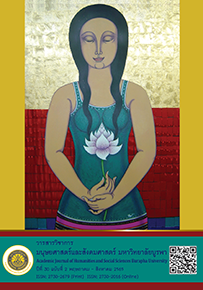Strategies for Translating Chinese Cultural Terms into Thai: Lao She’s Teahouse a Play in Three Acts
Main Article Content
Abstract
The objective of this paper was to examine the strategies employed in translating Chinese cultural terms appearing in Teahouse a play in three acts (《茶馆》) by Lao She’s (老舍). The Chinese manuscript and the Thai translated version by Princess Maha Chakri Sirindhorn were studied. Proper nouns of people and places, terms of address, food names, and idioms were analyzed. The results of the research showed that the transliteration strategy was often used to capture the nuances and meanings of the source language. It was found in translating specific names, such as people’s names, while the names of places were translated using transliteration with additional information in the parenthesis. The strategy of borrowed terms and everyday words was also used for stylistic purposes. Substitutions with cultural words in the target language were applied in translating terms of addresses, as they sounded more familiar to readers. The strategy of literal translation was used in translating some simple comparisons, while translation with explanation or implicit to explicit was employed in translating complicated idiomatic terms. These strategies contributed to better understanding of the texts.
Downloads
Article Details

This work is licensed under a Creative Commons Attribution-NonCommercial-NoDerivatives 4.0 International License.
บทความทุกบทความเป็นลิขสิทธิ์ของวารสารวิชาการมนุษยศาสตร์และสังคมศาสตร์ มหาวิทยาลัยบูรพาเท่านั้น
References
สำนักงานเลขาธิการวุฒิสภา. (2559). องค์ความรู้ เรื่อง หลักการเขียนคำกล่าวถวายพระพรชัยมงคลและคำกราบบังคมทูล ในโอกาสต่าง ๆ เพื่อสนับสนุนการปฏิบัติหน้าที่ของประธานวุฒิสภาและรองประธานวุฒิสภา หรือประธานสภานิติบัญญัติแห่งชาติและรองประธานสภานิติบัญญัติแห่งชาติของสำนักงานประธานวุฒิสภา. https://www.senate.go.th/assets/portals/49/files/handbook/km60/km7-60.pdf
ทิพา เทพอัครพงศ์. (2549). การแปลเบื้องต้น. สำนักพิมพ์จุฬาลงกรณ์มหาวิทยาลัย.
เธียรชัย เอี่ยมวรเมธ. (2553). พจนานุกรมจีน-ไทย. รวมสาส์น (1977).
ปรีชา สุขเกษม. (2544). สัตว์ในสำนวนไทย สิ่งชี้บ่งวัฒนธรรมความคิดของคนไทย. คณะมนุษยศาสตร์และสังคมศาสตร์ สถาบันราชภัฏเทพสตรี.
ราชบัณฑิตยสถาน. (2546). พจนานุกรมฉบับราชบัณฑิตยสถาน พ.ศ. 2542. นานมีบุ๊คส์พับลิเคชั่นส์.
ราชบัณฑิตยสถาน. (2556). พจนานุกรมฉบับราชบัณฑิตยสถาน พ.ศ. 2554 เฉลิมพระเกียรติพระบาทสมเด็จพระเจ้าอยู่หัว เนื่องในโอกาสพระราชพิธีมหามงคลเฉลิมพระชนมพรรษา 7 รอบ. ศิริวัฒนาอินเตอร์พริ้นท์.
เมสินีย์ ชอุ่มผล. (2561, 19 กันยายน). แม่ค้าเร่ขายของเล่นเด็กกระดาษ. http://www. Muangboranjournal.com/post/pong-pang
วรรณา แสงอร่ามเรือง. (2542). ทฤษฎีและหลักการแปล. โครงการตำราคณะอักษรศาสตร์ จุฬาลงกรณ์มหาวิทยาลัย.
ศศี จันทร์ประพันธ์. (2545). ปัญหาที่เกิดจากความแตกต่างระหว่างภาษาไทยกับภาษาอังกฤษในบริบทของการแปล: ตัวอย่างจากการสอนแปลไทย-อังกฤษ. วารสารภาษาและภาษาศาสตร์, 20(2), 22-34.
สุพรรณี ปิ่นมณี. (2549). การแปลขั้นสูง. สำนักพิมพ์จุฬาลงกรณ์มหาวิทยาลัย.
เหลาเส่อ. (2558). ร้านน้ำชา บทละครพูด 3 องก์. สมเด็จพระเทพรัตนราชสุดาฯ สยามบรมราชกุมารี (ผู้แปล). นานมีบุ๊คส์พับลิเคชั่นส์.
อัญชลี สิงห์น้อย. (2553). กลวิธีการแปลหน่วยสร้างประโยคเน้นส่วน. วารสารมหาวิทยาลัยนเรศวร, 18(3), 65-79.
อมรา ประสิทธิ์รัฐสินธุ์. (2540). ภาษาในสังคมไทย. สำนักพิมพ์แห่งจุฬาลงกรณ์มหาวิทยาลัย.
Aixinjueluo, Y. (2005). 老北京与满族 [Old Beijing and Manchu]. Xueyuan Press.
Baker, M. (1992). In other words. Routledge.
Barnwell, K. (1980). Introduction to semantics and translation. Summer Institute of Linguistics.
Cihai Editorial Committee. (1979). 辞海 [Cihai]. Shanghai Lexicographical Publishing House.
Deng, Sh. (1982). 老舍近十年的话剧创作 [Lao She’s nearly ten years of artistic drama creation]. In 老舍的话剧艺术 [Lao She’s drama art] (pp. 537-578). Culture & Art Pubilishing House.
Department of Modern and Contemporary Literature, CCRTU. (1988). 茶馆选自中国当代文学作品 [Teahouse selected works of contemporary Chinese literature]. Central Radio & TV University press.
Economic and Commercial Office of the Chinese Consulate General in Mandalay. (2005, October 18). 缅甸的“乌龟石”-玛瑙原石 [Burma’s “Turtle Stone” agate rough]. https://www.mfa.gov.cn/ce/cgmandalay/chn/mbly/MDXB/t217301.htm
Handian. (2004). 夹袍 [Jiapao]. https://www.zdic.net/hans/%E5%A4% BE%E8%A2%8D
Hodson, J. (2014). Dialect in film and literature. Palgrave Macmillan.
Hu, M. (2004). 汉语礼仪用语及其文化内涵 [Chinese etiquette and cultural connotation]. Shanghai Lexicographical Publishing House.
Huaren Baike Editorial Board. (1998). 烂肉面 [Meat noodles]. https://www.its fun.com. tw/%E7%88%9B%E8%82%89%E9%9D%A2/wiki-1736811-6731211
Institute of Linguistics, CASS. (2007). 现代汉语词典 [The contemporary Chinese dictionary]. The Commercial Press.
Lao She. (1984). 出口成章 [An outstanding eloquence]. People’s Literature Publishing House.
Larson, M. (1998). Meaning-based translation: A guide to cross-language equivalence. University Press of America.
Meiri Toutiao. (2019, June. 3). 北京話里的‘孫子’有幾個意思 ? [What is the meaning of “grandson” in Beijing dialect?]. https://kknews.cc/zhsg/culture/r5korro.html
Meiri Toutiao. (2019, November 18). 文财神范蠡,从政经商比胡雪岩高明! 陶朱之富 [Fan Li god of wealth: Tao Zhu]. https://kknews.cc/history/ 3qa99j3.html
Newmark, P. (1988). A textbook of translation. Prentice Hall.
Nida, E. A. (1964). Linguistics and ethnology in translation problems. In D. Hymes (Ed.), Language in culture and society: A reader in linguistics and anthropology. Harper & Row.
Qianpian Guoxue. (2021). 陶朱 [Tao Zhu]. https://cidian.qianp.com/ci/
The Commercial Editorial Board. (1988). 辞源(修订本) [Ciyuan] (Revised edition). The commercial Press.
Wang, T., Luan, Z., Chang, X., & Bao, K. (1992). 中国成语大辞典 [Dictionary of Chinese Idioms]. Shanghai Lexicographical Publishing House.
Wu, P. (2012). 对外汉语教学中的文化词语 [Cultural words in teaching Chinese as a foreign language]. Beijing World Publishing Corporation.
Ye, D., Wu, B., Wang, W., Li, Y., Qin, J., & Chen, Q. (1992). 中国风俗词典 [Dictionary of Chinese customs]. Shanghai Lexicographical Publishing House.
Yi, L. (2020). 王佐良: 一个真正意义的文化人 [Wang Zuolian: A cultural person]. http://www.cctss.org/article/headlines/6028


